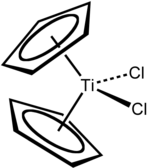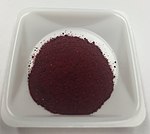
Back ثنائي كلوريد التيتانوسين Arabic تیتانوسن دی کولورید AZB Titanocendichlorid German تیتانوسن دیکلرید Persian Titanoseenidikloridi Finnish Dichlorure de titanocène French Dicloruro di titanocene Italian Titanoceendichloride Dutch Dicloreto de titanoceno Portuguese 二氯二茂钛 Chinese

| |

| |

| |
| Names | |
|---|---|
| IUPAC name
Dichloridobis(η5-cyclopentadienyl)titanium
| |
| Other names
titanocene dichloride, dichlorobis(cyclopentadienyl)titanium(IV)
| |
| Identifiers | |
3D model (JSmol)
|
|
| ChemSpider | |
| ECHA InfoCard | 100.013.669 |
| EC Number |
|
PubChem CID
|
|
| RTECS number |
|
| UNII | |
| UN number | 3261 |
CompTox Dashboard (EPA)
|
|
| |
| |
| Properties | |
| C10H10Cl2Ti | |
| Molar mass | 248.96 g/mol |
| Appearance | bright red solid |
| Density | 1.60 g/cm3, solid |
| Melting point | 289 °C (552 °F; 562 K) |
| sl. sol. with hydrolysis | |
| Structure | |
| Triclinic | |
| Dist. tetrahedral | |
| Hazards[1] | |
| GHS labelling: | |

| |
| Warning | |
| H315, H335 | |
| P201, P202, P261, P264, P270, P271, P280, P281, P301+P310, P301+P312, P302+P352, P304+P340, P305+P351+P338, P308+P313, P312, P330, P332+P313, P337+P313, P362, P403+P233, P405, P501 | |
| NFPA 704 (fire diamond) | |
| Related compounds | |
Related compounds
|
Ferrocene Zirconocene dichloride Hafnocene dichloride Vanadocene dichloride Niobocene dichloride Tantalocene dichloride Molybdocene dichloride Tungstenocene dichloride TiCl4 |
Except where otherwise noted, data are given for materials in their standard state (at 25 °C [77 °F], 100 kPa).
| |
Titanocene dichloride is the organotitanium compound with the formula (η5-C5H5)2TiCl2, commonly abbreviated as Cp2TiCl2. This metallocene is a common reagent in organometallic and organic synthesis. It exists as a bright red solid that slowly hydrolyzes in air.[2] It shows antitumour activity and was the first non-platinum complex to undergo clinical trials as a chemotherapy drug.[3]
- ^ "Summary of Classification and Labelling". Retrieved 5 December 2021.
- ^ Budaver, S., ed. (1989). The Merck Index (11th ed.). Merck & Co., Inc.
- ^ Cite error: The named reference
anti-cancerwas invoked but never defined (see the help page).
© MMXXIII Rich X Search. We shall prevail. All rights reserved. Rich X Search
